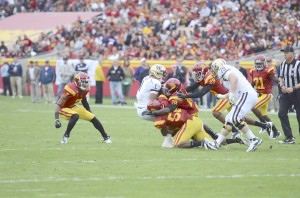Trojans key in on speed to stop spread
Perhaps no player embodies USC’s recent defensive transformation more than sophomore linebacker Dion Bailey. In part, that’s because of his size.

Speed kills · Three sophomores anchor USC’s linebacking corps. Dion Bailey (18) and Lamar Dawson (55) combined for 106 tackles in 2011. – Daily Trojan file photo
Bailey stands at 6 feet tall and weighs 210 pounds, which is roughly the size of the prototypical wide receiver or defensive back, not the standard linebacker. He’s smaller than most at his position — so small that USC might not have even offered him a scholarship 10 years ago. But he is quick: His motor rarely stops running, and he can cover a lot of ground.
A converted safety, Bailey starkly contrasts some of the Trojans’ recent All-American linebackers, such as Brian Cushing and Rey Maualuga, who were each at least two inches taller and 50 pounds heavier than Bailey.
But Bailey represents the latest trend in college football and at USC: prioritizing speed over size.
“We do that on purpose,” said Scottie Hazelton, the Trojans’ linebackers coach. “We get speed guys in there, because when teams go to the one-back or the spread stuff, you need a guy like that to run outside the box. The days of the big 250-pound linebackers are gone.”
As the season opener on Sept. 1 against Hawai’i nears, USC’s defense has evolved to emphasize speed as a way to stop spread offenses, which are increasingly common throughout the Pac-12 and college football.
The spread is an umbrella term that describes a variety of wide-open offenses that range from the zone-read option installed by Chip Kelly at Oregon to the Air Raid offense triggered under Mike Leach at Washington State.
There are variations, but the unifying principals are these: no huddle, shotgun snap, one running back, no fullback and four or five wide receivers.
The goal, first and foremost, is to spread defenders across the width of the field to give running backs and receivers more space. This is why hybrid linebackers in the mold of Bailey are so common nowadays, smaller but more comfortable in pass coverage and closing in to tackle a player in space.
Defenses, especially out west, have adjusted in the hope of slowing down teams that utilize the spread system, most notably Oregon. And it’s easy to grasp why: The Ducks have won three consecutive conference titles while averaging more than 40 points per contest in each of the last two season — the first school in Pac-12 history to do so.
“We’re getting more speed on the field,” Bailey said. “We’re not playing in the SEC, you know, ground and pound. We have to be able to run sideline to sideline. That’s how we’ve built our defense.”
Naturally, the Trojans’ top two strongside linebackers are now converted defensive backs in Bailey and senior Tony Burnett, who moved over during the spring.
“Really, your linebackers are becoming defensive ends, your smaller [defensive] backers are becoming your inside backers and your safeties are becoming outside linebackers,” Hazelton said. “It’s the way of the world.”
Hybrid defenders give schools an advantage in that coaches don’t have to change schemes. They’re not tossing aside playbooks and changing philosophies to combat the spread. They’re targeting different types of athletes.
“You have to recruit differently,” said USC defensive coordinator Ed Orgeron. “More speed. And it’s not just speed. These guys have to make plays in open spaces, because the spread teams’ll create one on ones.”
Initially, teams combated the spread by instituting “Nickel” or “Dime” packages that would bring in an extra defensive back, or two, as in the latter case. This strategy, however, would mean their defenses would be vulnerable against a good running game or a balanced spread team.
So for USC, which has utilized a 4-3 defense for the last decade, four down lineman and three linebackers, it doesn’t need to dramatically switch schemes. It’s just using different players such as Bailey, big enough to inch close to the line of scrimmage and stop a bruising fullback, and quick enough to stay with a speedy wideout 20 yards down field. And it can disguise coverages, too.
But this defensive makeover, so to speak, hasn’t occurred overnight.
Two years ago, USC posted its worst statistical season since 1955, giving up 400 yards per game — a program worst. And through the first five games last fall, that average mark improved by just 20 yards per contest.
“Oh, we were still new to the system,” Bailey said, trying to hold back a grin. “Our first year, we were extremely bad. Our second year, we were just trying to turn it around. We had a lot of new guys. Now, we actually have some experience.”
The Trojans certainly do have some experience with eight returning starters back on defense, including injured senior defensive end Devon Kennard, who tore a pectoral muscle in late July and could miss most of the season. The entire back seven returns, highlighted by preseason candidate for the Thorpe Award as the top defensive back and All-American free safety T.J. McDonald, who chose to forgo the NFL draft and return for his senior season.
And then again, there’s also Bailey, who along with sophomore linebacker Hayes Pullard, who last year led the team in tackles with 81.
“We have all the guys in place,” McDonald said. “We have to keep doing what we’re doing, but I think we’ll be that shutdown defense that everybody is asking for.”
